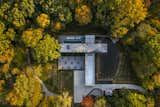[ad_1]
In Fishers, Indiana, just north of Indianapolis, Daniel and Lucy Neely were anticipating a major overhaul of their 1970s home when they arrived at the decision to tear it down and start over. Dreaming of a contemporary design, the couple fell in love with a home they stumbled across in the pages of Dwell—Höweler + Yoon Architecture’s Bridge House in McLean, Virginia.
Several shapes and configurations were initially presented, but the Neelys immediately fell in love with the “plus sign” concept proposed by the Höweler + Yoon team. “The four wings each face a particular view, so the house becomes like a viewing device—like an inhabitable telescope,” says architect Eric Höweler.
Daniel and Lucy met Höweler + Yoon co-founder Eric Höweler in McLean, where they were treated to a private tour of Bridge House, leaving no doubt they wanted to engage the firm to design their own home in Indiana. “After meeting Eric and touring the house, we knew immediately that we wanted him to design our home,” recalls Lucy.
In Fishers’ Forest Knoll neighborhood, the six-acre parcel included both mature trees and an existing pond—natural features the Neelys were eager to highlight. Functionally, they also needed an autonomous space for each of their three daughters, and a design that would allow them to comfortably age in place. Letting the site’s natural beauty guide the design, the Höweler + Yoon team proposed a cruciate, or cross-shaped, form. “We proposed the plus shape as an elemental form that would organize the landscape around it,” says Höweler. “Kind of like a mark on a map—plus marks the spot.”
The kitchen, by design, is at the center of the “plus,” where the home’s two intersecting volumes overlap. The four first floor wings include a living room, dining room, primary bedroom suite, and entry foyer with power room and gym. The upper floor consists of three bedrooms, all en suite, for the couple’s three daughters.
Each of the plus’s four radials is aligned to a cardinal direction, with the dramatic two-story western exposure overlooking the property’s pond. “The glazed areas are designed to precisely frame views back out to the landscape,” says Höweler. “The geometry ensures that each wing has its own orientation and its own views.”
While the home’s form and layout were relatively straightforward decisions for the Neelys, the exterior cladding proved more of a conundrum. “We wanted low-maintenance, durability, and a dramatic appearance,” says Daniel. After considering limestone, corten steel, fiber cement panels, and stucco, the Höweler + Yoon team proposed yakisugi—a material previously unknown to the Neelys. “We were attracted to the charred wood as an idea, because it has a natural protective layer,” says Höweler. “It also showcases the natural qualities of the material in dramatic ways.” Despite initially being unfamiliar with the material, the Neelys were quick to get on board. “Once we saw it, we absolutely fell in love with it,” says Lucy.
“I would describe the charred exterior as ‘blacker-than-black,’ as it seems to absorb all light striking it,” says Lucy of the home’s striking siding from Nakamoto Forestry. “The texture is unique and dramatic while still maintaining a connection to nature and sustainable materials.” Nakamoto Forestry uses logs from their sustainably planted and harvested forests in Japan.
To source the yakisugi for the project, the Höweler + Yoon team turned to Nakamoto Forestry. In addition to its rich, textural appearance, the heat-treated wood is sustainably sourced, has a reliable two- to three-week lead time, and is naturally resistant to fire, fungi, and water. “It has an almost mythical status amongst architects,” says Höweler. “Once we saw the samples, and the range of finishes, we were really taken by the varied textures and colors.” Höweler and team chose to weave together several different products and stains— Suyaki® Tung Oil Black, and Gendai® in both Alkyd Light Gray and Alkyd Black—to showcase subtle variations in intensity and composition.
Suyaki, an unbrushed variation of Nakamoto Forestry’s authentic Japanese yakisugi siding used on the Neelys’ home, is finished with tung oil to penetrate and stabilize the soot layer. The oil finish also incorporates a black pigment which enhances color saturation and contributes to the product’s bold, “blacker-than-black” appearance.
Höweler notes that another appeal of Nakamoto Forestry is the availability of authentic Japanese yakisugi in the North American market, made from sugi (a Japanese cedar species) and deeply heat-treated—not just cosmetically charred or chemically treated as is common with domestic producers. “They were able to supply the charred wood siding in a variety of finishes from their North American facilities,” says Höweler. “This made it possible to achieve this unique material without having to treat it ourselves, and without having to handle the import process.”
Having now lived in the home for several years, the Neelys appreciate observing the natural landscape around them as it changes throughout the year. “We most enjoy watching the change of seasons that takes place outside of the massive living room window,” says Daniel. The home’s jet-black exterior highlights and amplifies these seasonal shifts. “It provides a striking contrast to the green grass in spring and summer, the autumnal colors of fall, and particularly the brilliant white snow of winter,” says Lucy. “It is absolutely gorgeous throughout each of the seasonal changes, and we love it.”
Learn more at nakamotoforestry.com.
Project Credits:
[ad_2]








